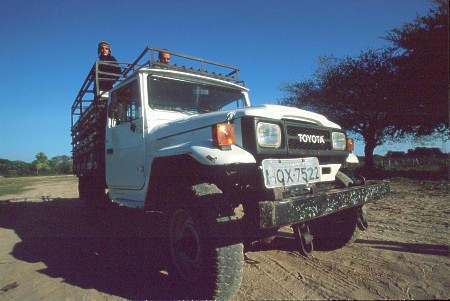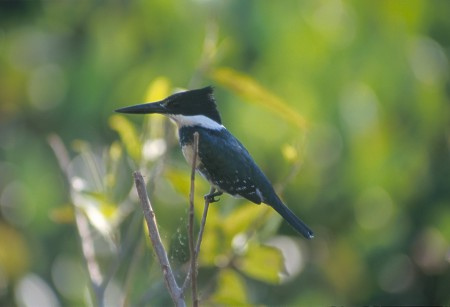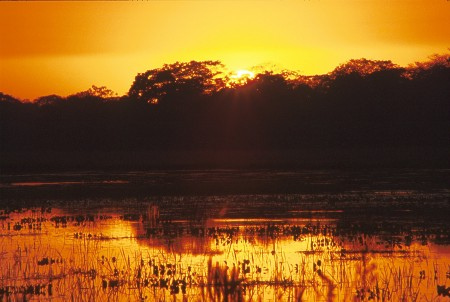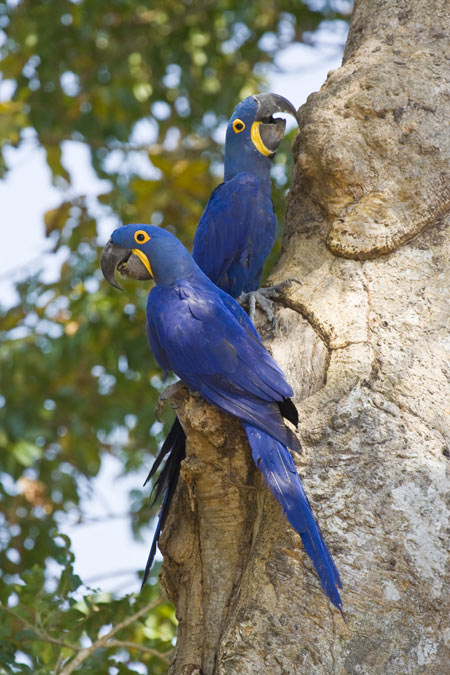Miranda
This is a popular location for tourists, with several well established Pantanal Lodges, such as the Refúgio Ecológico Caimain, which have earned a good reputation with international visitors and for their support of conservation efforts such as Projeto Arara Azul. The average temperature ranges between 20°C and 24°C depending on the time of year - dropping low as 10°C in the dry season (winter) and climb to 35°C in the wet season (summer).
History
Miranda was founded in 1778, with the construction of a military fort called Nossa Senhora do Carmo do Rio Mondego on the orders of the territorial governor, Caetano Pinto de Miranda. The location was close to the original site of Santiago de Xerés - an abandoned Spanish colony founded almost 200 years previously by the explorer Ruy Diaz de Malgarejo in 1579. The intent of the fortress was to protect the region from Paraguayan bandits who were then operating in the southern Pantanal region and harassing Portuguese settlers. A small town soon formed around it, becoming locally known as Mondego.
With rivers still being the primary means of transport, and navigation along the Miranda River (then known as the Mondego River) being difficult, the town struggled in its early years. It might also have been abandoned or re-located if it wasn't for the determination of its first citizens to construct a permanent home and expand the town. By 1800, the town had around 500 people, a main street (Rua do Carmo), a large church and about 40 houses constructed in wattle and daub, and adobe. In 1857, the settlement was formally recognised as a town, and re-named to Miranda in honour of the governor who had ordered the founding of the original military outpost. A military presence still remains in the town today with a training camp attached to Brazil's Western Military Command.
Most of the original buildings were destroyed and burnt by retreating Paraguayan forces following their occupation during the Paraguayan War - but post-war reconstruction resulted in the town's renewal and further expansion. In 1912, the arrival of both the telegraph service and the railroad ensured the town's integration with the rest of Brazil and stimulated a major boost in the local economy. Today, Miranda's economy is based on livestock, farming, ceramic manufacturing, fishing and eco-tourism. The region also contains several important Terena indigenous areas: Cachoeirinha, Lalima and Passarinho - where the inhabitants maintain their cultural traditions including their languages, dance, rituals and pottery.
Curiosities
The municipality experienced a small gold and diamond rush in the early 20th century during the construction of the railroad. In his book Land Without Evil, Richard Gott cites the memoirs of Sir Christopher Gibson, an Anglo-Argentine landowner who managed the Miranda Estancia cattle ranch. His memoirs, published in the 1930s, recall the event:
A workman picked up a "pretty stone" about the size of a pigeon's egg, and sold it for a few milreis to a Miranda shopkeeper. It proved to be a diamond of enormous value, which set off a handful of Negroes panning for gold and diamonds - with almost indecent results - in the Rio Aquidauana close to the eastern boundary of the Miranda Estancia.
Miranda Jesuit Missions
In his book, Land Without Evil, Richard Gott also referred to the story of several Jesuit missions (San José, Los Angeles, Encarnación, and San Pedro y Pablo) established along the Miranda river in the 1630s and 40s. Their aim was to convert the local Terena indians - with these missions being an extension of the Guaíra Mission, further south, sitting above the spectacular Sete Quedas waterfalls on the Paraná river. The Guaíra Mission was famously attacked and destroyed by Portuguese bandeirante slavers in the 1630s - providing some of the inspiration for the 1986 movie, The Mission (although the time period was changed for dramatic effect to the 1750s, coinciding with the Treaty of Madrid and later expulsion of the Jesuits).
The Belgian Jesuits who founded the Miranda missions had escaped the sacking of Guaíra, and worked hard to establish a good relationship with Miranda's local Terena indians. Unfortunately, the Bandeirantes soon followed the Jesuits from Guaíra - arriving in Miranda and resorting to deception, telling the Indians that they were also Jesuits who had been sent to gather the Indians for the founding of a new town where they would be looked after and instructed in religion. The Indians fell for the lie, with crowds coming in from far and wide - only to find themselves bound and then led off by the slavers. The real Jesuits tried to stop the Bandeirantes but were assaulted and chased off.
The Jesuits continued for some time afterwards, but without further success . They eventually retreated to the relative safety of Spanish territory in Paraguay. Aside from some records in the Jesuit archives, no ruins or trace of the Miranda missions remain.
Projeto Arara Azul
Although this project has since expanded to cover other Pantanal regions, the nucleus for Projeto Arara Azul occurred with the Miranda region. The project is considered one of the Pantanal, and Brazil's, greatest conservation success stories. When it was initiated in 1990, the Hyacinth Macaw (locally known as the Arara Azul) was on the brink of extinction - with less than 1500 wild birds, habitat destruction, and ongoing trapping for the pet trade by illegal smugglers. In the 20 years since its founding, it has succeeded in educating the local population in the importance of saving the birds, the Mandovi trees where they nest, and significantly reducing the illegal trapping. Not only has the population stabilised, but it has actually increased to around 5,000 wild birds today - to the point where the birds are now a relatively common sight in the Pantanal (although still rare and endangered over most of their former range). This success owes much to the efforts of local biologist, Neiva Guedes, and a dedicated team of volunteers who have studied the birds, and raised awareness of the macaws' plight. Habitat protection, installation of artificial nesting boxes, close monitoring of chicks, and hand rearing where necessary, have all played a role. The success also owes much to the efforts of local cattle ranchers supporting these conservation efforts, and closing their properties to the illegal trappers. Corporate sponsors, such as Toyota do Brasil, have provided products, publicity and funding to assist. Hence, if you're lucky enough to spot a Hyacinth Macaw during your visit to the Pantanal there's a very long list to thank.
Hyacinth Macaws are now a relatively common sight in the Pantanal, largely thanks to the efforts of Projeto Arara Azul.
Local Events
One of the biggest events in the local calendar is the Festa do Homem Pantaneiro, or Festival of Pantanal Culture, which occurs each October - organised by Sociedade de Defesa do Pantanal (Sodepan). This is a four-day extravaganza of rodeio, horse riding and pantaneiro traditions. Check the dates with the local hotels if you're planning a stay around this time.
Places to Eat
Miranda is only a very small town - so there isn't a huge choice for eating out. In most cases, visitors typically use the restaurant linked to their hotel or Pantanal Lodge. However, the following two locations might also be worthwhile checking out if you're in town.
Name
Description
Zero Hora
Rua Barão do Rio Branco 1146
Buffet restaurant located in the old bus station. Great selection of meats and vegetables. Restaurant and self-service.
Bento's Bar e Restaurante
Rua Marechal Floriano Peixoto, 357
Brazilian cuisine, served in good sized portion, and great value for money.
Places to Stay - in town
The list below may be useful in the event you need to spend the night. Neither hotel is luxurious - but comfortable, clean and fine for families. They typically cater for local Brazilian tourists. In most cases the hotel staff will speak Portuguese only - although you'll occasionally get someone working there who speaks English.
These hotels might also be a good source of information about local attractions and events (there's also a small tourist information booth in the bus station).
Name
Description
Pantanal Hotel
Rua Barão Do Rio Branco, 609, Miranda
www.pantanalhotel.com.br
Comfortable rustic character hotel located near the edge of town.
See Trip Advisor reviews.
Hotel Aguas do Pantanal
Avenida Afonso Pena, 367, Miranda
www.aguasdopantanal.com.br
Comfortable homey style of hotel, with helpful staff. Includes a small office selling Pantanal tours and lodge stays.
See Trip Advisor reviews.
Places to Stay - Pantanal Lodges
The following is a list of Pantanal Lodges within the Miranda region. Several further nearby lodges are listed in the guide for Aquidauana (which is only a short distance from Miranda). You can also use the interactive zoomable map on our Pantanal Maps page to see approximate locations.
Name
Description
Fazenda 23 de Março
33km north of Miranda by dirt road
www.fazenda23demarco.com.br
Fairly simple fazenda with only a small number of guest rooms. Not luxurious but relaxed, with attentive service and a great place to get away. Includes horse riding and jeep safaris.
See Trip Advisor reviews.
Fazenda Baía Grande
South of Miranda at km 20 on MS-448
www.fazendabaiagrande.com.br
Traditional cattle ranch popular with tourists, with excellent food, service, and wildlife viewing opportunities (although the variety of animals change with the seasons). Includes rheas, anteaters, caiman, capybara, armadillo and macaws - to name a few. Surrounded by cerrado grassland and several small lakes.
See Trip Advisor reviews.
Fazenda San Francisco
36km northwest of Miranda on BR-262
www.fazendasanfrancisco.tur.br
This easily accessible fazenda. It runs a sophisticated tourist operation alongside a working cattle ranch on their 15,000 ha property. It's also one of the few ranches catering for day-trippers, many of whom come out from nearby Miranda. It has great wildlife viewing opportunities - being reputedly one of the best locations to to view ocelots. There's good dining and 18 apartments for overnight stays. Activities include wildlife watching from 4x4 safaris, boats, night treks, horseback riding, and piranha fishing. On the downside, the popularity of its tours means it can get busy with tour groups passing through, and a few mixed reviews.
See Trip Advisor reviews.
Fazenda Santa Cruz
Exit at Km 527 on BR 262 between Miranda and Aquidauana, then 28km by dirt road
www.fazendasantacruz.tur.br
One of the oldest fazendas in the area, and is an ideal place both to see wildlife and learn about Pantaneiro culture. Activities include jeep safaris, horse riding, treks, and piranha fishing. It only has a small number of guest rooms, meaning you don't need to contend with a large number of other visitors.
See Trip Advisor reviews.
Pantanal Ranch Mandovi
3.5km outside Miranda on BR-262. Located at km 554, in front of the Tratormil
pantanalranchmandovi.com
Good, friendly budget option run by an enthusiastic local guide of Kadiwèu indian descent, and his Swiss partner. A camping option is also available.
See Trip Advisor reviews.
Pantanal Ranch Meia Lua
10km east of Miranda on BR-262. Located at km 547.
pantanalranchmeialua.com
Fazenda run by Swiss Mirjam Goring (also involved with Pantanal Ranch Mandovi). Has only been running a short time but is quickly building a solid reputation. Has all the usual Pantanal activities you'd expect - with some extra fun such as Pantanal Cooking and Caiparinha-making classes. Also arranges tours in nearby Bonito.
See Trip Advisor reviews.
Refúgio da Ilha
28km northeast of Miranda.
refugiodailha.com.br
The lodge has 8 small but comfortable apartments, with air conditioning and wi-fi. It's easily accessible, located 18km outside Miranda, and a further 10km off the main BR-262 highway. It is notable as the location for several documentaries including Raising Sancho, about an orphaned giant otter cub. The lodge offers photo safaris, horse riding, boatong, fishing, and (if conditions are right) diving. The minimum stay is three days.
See Trip Advisor reviews.
Refúgio Ecológico Caiman
36km northeast of Miranda along a rural road.
www.caiman.com.br
The best known eco-tourism lodge in the region, R.E. Caiman has a reputation for well-run tours, and has been an active sponsor and participant of conservation programmes including Projeto Arara Azul. There are several guest houses on the property all offering something slightly different. It has excellent and well-trained English-speaking guides with a good knowledge of the wildlife. The large property and a range of habitats ensures that you'll see a good range of wildlife. There's also an opportunity to experience local culture by joining pantaneiro cowboys out on cattle rides, spending the night way from the usual guest house - although this depends on the time of year and scheduled stock movements.
See Trip Advisor reviews.
Getting there
Air: Since its only a small town, there are no regularly scheduled air services. However, Air taxis may be required to access some remote fazendas. One-way prices to fly out from Campo Grande range USD 500-1500 depending on the location and size of aircraft. This price can be split among multiple passengers if travelling in groups although there may be luggage restrictions depending on number of passengers and capacity of the plane. Air taxis can be booked from Campo Grande airport or via the links below:
Amapil Táxi Aéreo
Mato Grosso do Sul Táxi Aéreo
Pan Air Táxi
Bus: Miranda is three hours by bus from Campo Grande (via Aquidauana), with a further three hours needed if travelling onward to Corumbá. Services are run by Andorinha and other local companies every few hours. Vans can also be arranged to Bonito - although you may need to check details with your hotel or at the bus station. See the link below for times and bookings:
Road: Miranda sits midway between Corumbá and Campo Grande on the BR-262 (and about an hour from Aquidauana). The road is paved and can be used year-round. Some fazendas within the region need to be accessed via unpaved dirt roads which may become boggy and difficult to access in the wet season.
Train: A specialty tourist train service, known as the Trem do Pantanal formerly ran weekly between Campo Grande and Miranda, via Aquidauana. This offered great views of the Pantanal but was suspended in 2015.








Banner image: Ocelot (Shutterstock/M. Lorenz).
Hyacinth Macaws (Shutterstock/Ecoventurestravel).
Footer images: Andrew Mercer

Pantanal Escapes